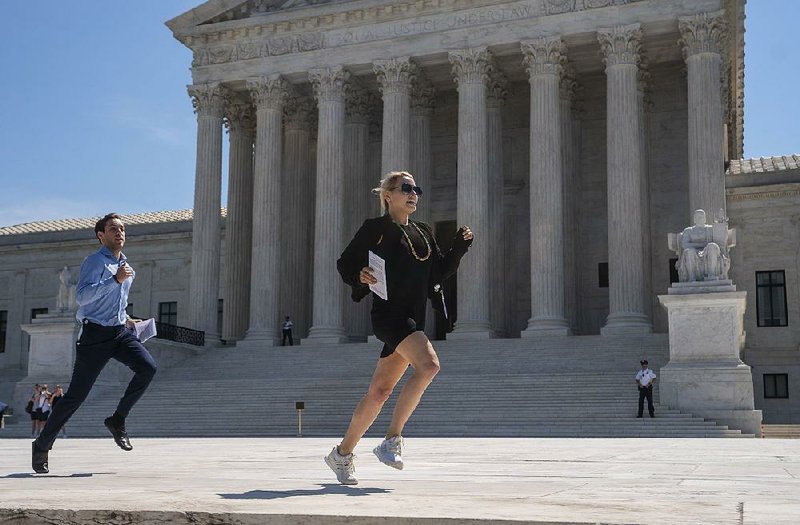WASHINGTON -- The Supreme Court ruled Thursday that federal courts are powerless to hear challenges to gerrymandering, the practice in which the party that controls the state legislature draws voting maps to help elect its candidates.
The vote was 5-4, with the court's more conservative members in the majority. In a momentous decision, the court closed the door on such claims.
The drafters of the Constitution, Chief Justice John Roberts wrote for the majority, understood that politics would play a role in drawing election districts when they gave the task to state legislatures. Judges are not entitled to second-guess lawmakers' judgments, he said.
"We conclude that partisan gerrymandering claims present political questions beyond the reach of the federal courts," the chief justice wrote.
Gerrymandering is almost as old as the nation, and both parties have used it. But in recent years, as Republicans captured state legislatures around the country, they have been the primary beneficiaries. Aided by sophisticated software, they have drawn oddly shaped voting districts to favor their party's candidates. Should Democrats capture state legislatures in the next election, the ruling would allow them to employ the same tactics.
In a dissent delivered from the bench, Justice Elena Kagan said American democracy will suffer thanks to the court's ruling in the two consolidated cases decided Thursday, Rucho v. Common Cause, No. 18-422, and Lamone v. Benisek, No. 18-726.
"The practices challenged in these cases imperil our system of government," she said. "Part of the court's role in that system is to defend its foundations. None is more important than free and fair elections."
Gerrymandering at its most extreme "amounts to 'rigging elections,'" Kagan wrote, quoting retired Justice Anthony Kennedy in a case from 2004.
The practice allows politicians to "cherry-pick voters to ensure their re-election," she wrote.
She added that she was dissenting "with deep sadness." Justices Ruth Bader Ginsburg, Stephen Breyer and Sonia Sotomayor joined Kagan's dissent.
Roberts did not say the current system of drawing districts is desirable as a matter of policy.
"Our conclusion does not condone excessive partisan gerrymandering," Roberts wrote, acknowledging that the North Carolina and Maryland maps are "highly partisan."
"Excessive partisanship in districting leads to results that reasonably seem unjust," he wrote.
"The districting plans at issue here are highly partisan, by any measure," he wrote. "The question is whether the courts below appropriately exercised judicial power when they found them unconstitutional as well."
The answer, he wrote, is no, as courts lack the authority and competence to decide when politics has played too large a role in redistricting. "There are no legal standards discernible in the Constitution for making such judgments," the chief justice wrote, "let alone limited and precise standards that are clear, manageable and politically neutral.
"Federal judges have no license to reallocate political power between the two major political parties, with no plausible grant of authority in the Constitution and no legal standards to limit and direct their decisions," Roberts wrote.
Justices Clarence Thomas, Samuel Alito, Neil Gorsuch and Brett Kavanaugh joined the majority opinion.
In dissent, Kagan said the court had abdicated one of its most crucial responsibilities.
"The only way to understand the majority's opinion," she wrote, "is as follows: In the face of grievous harm to democratic governance and flagrant infringements on individuals' rights -- in the face of escalating partisan manipulation whose compatibility with this nation's values and law no one defends -- the majority declines to provide any remedy. For the first time in this nation's history, the majority declares that it can do nothing about an acknowledged constitutional violation because it has searched high and low and cannot find a workable legal standard to apply."
Federal courts in five states had concluded that redistricting plans put in place under one party's control could go too far and that there were ways to identify and manage excessively partisan districts. Those courts included 15 federal judges appointed by Republican and Democratic presidents reaching back to Jimmy Carter.
The Supreme Court's decision effectively reverses the outcome of rulings in Maryland, Michigan, North Carolina and Ohio, where courts had ordered new maps drawn, and ends proceedings in Wisconsin, where a retrial was supposed to take place this summer after the Supreme Court last year threw out a decision on procedural grounds.
One case decided Thursday, from North Carolina, concerned a plan drawn by Republican state lawmakers in 2016 that included a criterion called "partisan advantage."
The state's congressional delegation, in a purple state in which neither party had a distinct edge, was at the time made up of 10 Republicans and three Democrats. A key goal, lawmakers said, was "to maintain the current partisan makeup of North Carolina's congressional delegation."
"I think electing Republicans is better than electing Democrats," explained David Lewis, a Republican member of the General Assembly's redistricting committee. "So I drew this map to help foster what I think is better for the country.
"I propose that we draw the maps to give a partisan advantage to 10 Republicans and three Democrats," he said, "because I do not believe it's possible to draw a map with 11 Republicans and two Democrats."
The plan worked. In 2016, Republican congressional candidates won 53% of the statewide vote. But, as predicted, they again won in 10 of the 13 congressional districts, or 77% of them.
In 2018, the statewide vote was about evenly divided, but Democrats again secured only three seats.
The case was an appeal from a decision in August by a three-judge panel of a U.S. District Court in North Carolina. The ruling found that Republican legislators there had violated the Constitution by drawing the districts to hurt the electoral chances of Democratic candidates.
The other case, from Maryland, was filed by Republican voters who said Democratic state lawmakers had in 2011 redrawn a district to retaliate against residents who supported its longtime incumbent, Rep. Roscoe Bartlett, a Republican. That retaliation, the plaintiffs said, violated the First Amendment by diluting their voting power.
Bartlett had won his 2010 race by a margin of 28 percentage points. In 2012, he lost to Rep. John Delaney, a Democrat, by a 21-point margin.
Last year, after the Supreme Court returned the case to the U.S. District Court in Maryland, a three-judge panel of that court ruled for the challengers, barred state officials from conducting further congressional elections using the 2011 maps and ordered them to draw new ones.
Redistricting will next take place in 2021, once 2020 census results are available.
Information for this article was contributed by Adam Liptak of The New York Times; and by Mark Sherman and Jessica Gresko of The Associated Press.
A Section on 06/28/2019

